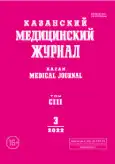Опыт применения малоинвазивного метода удаления конкремента из протока слюнной железы под контролем сонографии
- Авторы: Иванов О.А.1, Шарафисламов И.Ф.1, Воронина Э.М.1, Ксембаев С.С.2, Хамзин И.И.1
-
Учреждения:
- Городская клиническая больница №7
- Казанский государственный медицинский университет
- Выпуск: Том 103, № 3 (2022)
- Страницы: 516-521
- Тип: Обмен клиническим опытом
- URL: https://journal-vniispk.ru/kazanmedj/article/view/90553
- DOI: https://doi.org/10.17816/KMJ2022-516
- ID: 90553
Цитировать
Полный текст
Аннотация
Актуальность. Удаление конкрементов при слюннокаменной болезни — одна из актуальных проблем челюстно-лицевой хирургии и хирургической стоматологии ввиду сложности проведения манипуляции, травматичности методики и частого развития осложнений.
Цель. Улучшение результатов лечения пациентов со слюннокаменной болезнью путём применения разработанной нами методики малоинвазивного удаления конкрементов, находящихся в любом отделе выводного протока поднижнечелюстной и/или околоушной слюнных желёз, под постоянной ультразвуковой визуализацией хода вмешательства.
Материал и методы исследования. В исследование вошли пациенты с диагнозом слюннокаменной болезни (10 человек: 9 мужчин и 1 женщина в возрасте 18–50 лет, средний возраст 44,2±1,25 года). Методика заключалась в следующем. Подводили ультразвуковой датчик со стороны кожи, определяли местоположение конкремента в протоке железы. Далее чрескожно через прокол вводили иглу диаметром 0,3 см с мандреном в проток слюнной железы к дистальной поверхности конкремента, продвигали его с помощью иглы максимально в сторону устья выводного протока. Затем выводили иглу, оставляя в протоке мандрен, с помощью которого фиксировали конкремент в новом положении. После бужирования выводного протока вводили в него корзинку Дормиа, захватывали и удаляли конкремент. Манипуляции выполняли под постоянной ультразвуковой визуализацией.
Результаты. Использование разработанной нами методики малоинвазивного удаления конкремента диаметром до 5 мм, находящегося в любом отделе выводного протока поднижнечелюстной и/или околоушной слюнных желёз, под постоянной ультразвуковой визуализацией хода вмешательства позволило достичь положительного результата у всех 10 пациентов, включённых в клинические наблюдения.
Вывод. Разработанная нами малоинвазивная методика удаления конкрементов из выводных протоков слюнных желёз под постоянной ультразвуковой визуализацией позволяет добиться облегчения манипуляции, её наглядности и точности, а также атравматичности и профилактики развития осложнений.
Полный текст
Открыть статью на сайте журналаОб авторах
Олег Александрович Иванов
Городская клиническая больница №7
Email: o4lh@mail.ru
ORCID iD: 0000-0002-4394-5480
канд. мед. наук, доц., зав. отделением челюстно-лицевой хирургии
Россия, г. Казань, РоссияИскандер Фоатович Шарафисламов
Городская клиническая больница №7
Email: Sharusi333@gmail.com
руководитель Центра рентгенохирургических вмешательств
Россия, г. Казань, РоссияЭлина Михайловна Воронина
Городская клиническая больница №7
Email: elina.voronina@gmail.com
ORCID iD: 0000-0001-6398-4690
челюстно-лицевой хирург, врач отделения челюстно-лицевой хирургии
Россия, г. Казань, РоссияСаид Сальменович Ксембаев
Казанский государственный медицинский университет
Автор, ответственный за переписку.
Email: ksesa@mail.ru
ORCID iD: 0000-0002-0791-1363
докт. мед. наук, проф., зав. каф., каф. челюстно-лицевой хирургии и хирургической стоматологии
Россия, г. Казань, РоссияИльдар Илдусович Хамзин
Городская клиническая больница №7
Email: endohamzin@mail.ru
ORCID iD: 0000-0001-8517-4453
зав. отделением эндоскопии
Россия, г. Казань, РоссияСписок литературы
- Ромачева И.Ф., Юдин Л.А., Афанасьев В.В., Морозов А.Н. Заболевания и повреждения слюнных желёз. М.: Медицина; 1987. 240 с.
- Панин А.М., Гайдук И.В. Заболевания и повреждения слюнных желёз. В кн.: Челюстно-лицевая хирургия. Под ред. А.Ю. Дробышева, О.О. Янушевича. М.: ГЭОТАР-Медиа; 2018. с. 349–398.
- Huoh KC. Etiologic factors in sialolithiasis. Otolaryngol Head Neck Surgery. 2011;145(6):935–939. doi: 10.1177/0194599811415489.
- Hung SH, Lin HC, Su CH, Chung SD. Association of sialolithiasis with cholelithiasis: A population-based study. Head Neck. 2016;38(4):560–563. doi: 10.1002/hed.23926.
- Stack BCJr, Norman JG. Sialolithiasis and primary hyperparathyroidism. Otorhinolaryngol Relat Spec. 2008;70(5):331–334. doi: 10.1159/000149836.
- Hung SH, Huang HM, Lee HC, Ching Lin H, Kao LT, Wu CS. A population-based study on the association between chronic periodontitis and sialolithiasis. Laryngoscope. 2016;126(4):847–50. doi: 10.1002/lary.25360.
- Wu CC, Hung SH, Lin HC, Lee CZ, Lee HC, Chung SD. Sialolithiasis is associated with nephrolithiasis: a case-control study. Acta Otolaryngol. 2016;136(5):497–500. doi: 10.3109/00016489.2015.1129068.
- Hung SH, Xirasagar S, Cheng YF, Lin HC. A case-control study of the association between sialolithiasis and osteoporosis. Clin Otolaryngol. 2019;44(3):343–348. doi: 10.1111/coa.13310.
- Сиалоэндоскопия как метод удаления конкрементов из слюнной железы. Клуб стоматологов. https://stomatologclub.ru/stati/hirurgiya-12/sialoendoskopiya-kak-metod-udaleniya-konkrementov-iz-slyunnoj-zhelezy-3096/ (дата обращения: 15.10.2019).
- Афанасьев В.В., Абдусаламов М.Р., Курбанов С.М. Сиалоэндоскопия — новый метод диагностики и лечения больных слюннокаменной болезнью. Границы необходимости использования. Стоматология. 2018;97(4):28–30. doi: 10.17116/stomat20189704128.
- Гильфанов Б.Р., Иванов О.А., Воронина Э.М., Шарифисламов И.Ф., Ксембаев С.С., Хамзин И.И. Способ удаления конкремента из протока слюнной железы. Патент РФ на изобретение №2745359. Бюлл. №9 от 24.03.2021.
Дополнительные файлы






